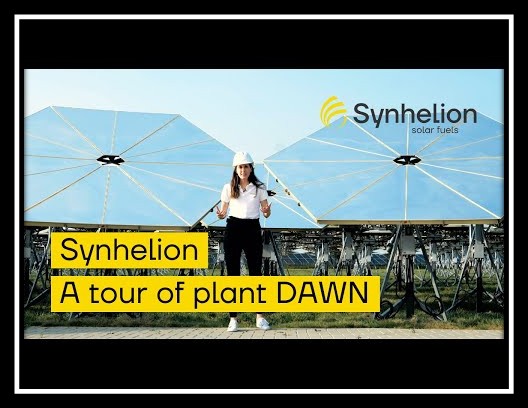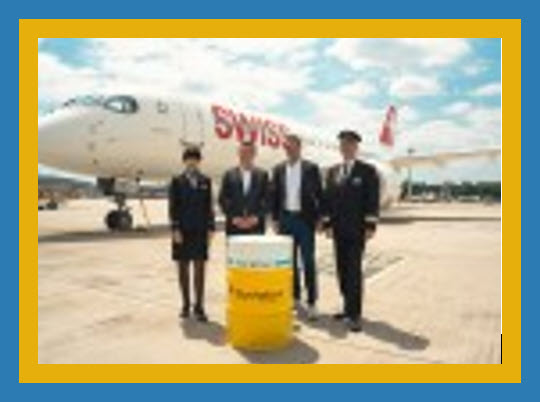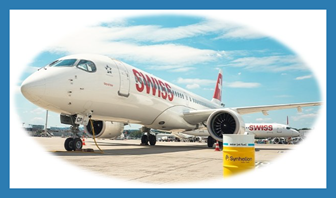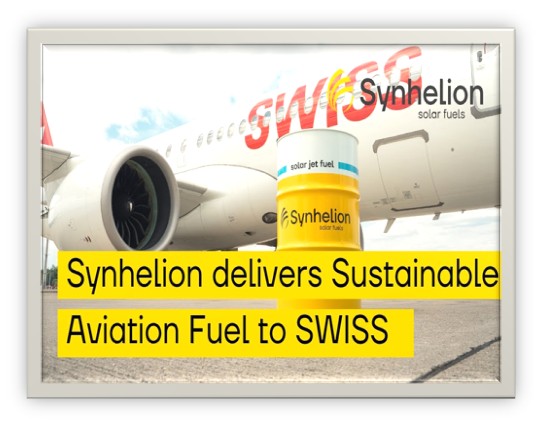Swiss Alchemy creates SAF with the SUN ???

Intriguing article (below) about creating a greener fuel source and this new option relies heavily on THE SUN.
Other than some of the advances in aerospace (AAMs, UASs, SSTs and more), the aviation news focuses on Sustainable Aviation Fuels (SAF) and multiple efforts to reduce Carbon Emissions based on many prosing research/development initiatives. Here are a few:
- RISE’s innovative patent: Green Positive?
- GREAT GREEN NEWS: Pittsburgh brings SAF production on airport
- FAA’s FAST awards towards the 2050 Zero Carbon Emissions GoaL
- UPDATE ON H2 PROGRESS TOWARD ZERO CARBON EMISSIONS
- Positive Prospect in HYDROGEN as an aircraft power source
- What’s in Aviation’s GREEN BASKET?
- BRAZIL’S GREEN AVIATION INNOVATION’S AWARD
- Great Report Card from EIA on SAF
- More SAF feedstocks = cheaper green fuel?
That’s an impressive array of promising endeavors, but the below article about SYNHELION[i] a innovative venture THAT “TURNS SUNLIGHT INTO FUEL.” As its website explains, “Solar fuels are synthetically produced fuels designed to mimic the chemical and physical properties of fossil fuels.” [footnote two below offers a more complete explanation of how this process works its alchemy] Here is a graphic display of what happens:
A page in Synhelion’s website reviews the seven ways that its sun fuel BENEFITS THE ENVIRONMENT AND COULD REALISTICALLY BE UTILIZED BY COMMERCIAL AVIATION:
The company does not overstate the status of its synthetic fuel, “…there’s still a long way to go. The production infrastructure required for commercial levels is still in its infancy, and availability is poor.” Honesty but still promising.
In addition to seeking sustainability certification for both fuel and production process under the EU Renewable Energy Directive, Synhelion might consider achieving the same status with the FAA[ii]; FOR HELP ◄
Solar Jet Fuel Used for the First Time in Civil Aviation
Photo: Synhelion
A reputable European airline and a clean tech startup are the players behind a pioneering move related to green aviation: SOLAR FUEL WAS USED FOR THE FIRST TIME IN CIVIL AVIATION, and it was successful. In terms of numbers, it is only a small step, but the implications are tremendous, paving the way for a cost-efficient, sustainable alternative to conventional jet fuel.
SAF (sustainable aviation fuel) is a term that is currently widely used when talking about zero-emission aviation, but solar fuel isn’t a well-known alternative to conventional fuel. Solar jet is a type of synthetic crude oil produced using solar energy. Synhelion, a Swiss-based clean tech startup, describes the process of making solar jet fuel[i] as a combination of affordable feedstock, cheap renewable energy, and cost-effective thermal storage.
SYNHELION has benefited from support from Swiss (Swiss International Airlines) since 2020. That is when Swiss became a strategic partner. Two years later, it turned into an investor. Five years after their collaboration began, Swiss and Synhelion were able to demonstrate the use of solar fuel in civil aviation for the first time. It was a premiere for the entire aviation industry.
Although both players are based in Switzerland, the solar fuel was delivered and used in Germany. That’s because it was used as part of the fuel needed for a Hamburg-Zurich flight. First, Synhelion[ii] delivered a barrel of its synthetic crude oil to a refinery in Northern Germany. Here, the oil was processed and turned into certified Jet-A-1 aviation fuel.
The crude oil used for this industry trailblazing delivery was manufactured at
using proprietary thermal energy storage system. [CLICK on image to see fascinating video on the process.]
For the next phase, this processed fuel was integrated into the fuel supply system at Hamburg Airport, from which it was then used for Swiss flight operations. It wasn’t something big, like an entire flight powered by solar fuel, but it was a first step and a symbolic start.
This first use of solar fuel wasn’t about quantity, but about getting the ball rolling. Synhelion only delivered a 190-liter (50 gallons) barrel of crude oil, and the resulting jet fuel represented only around seven percent of the total fuel needed for a Hamburg-Zurich flight. The goal was to confirm that THIS ALTERNATIVE FUEL CAN BE SUCCESSFULLY USED TO POWER AIRPLANES via a seamless logistical process.
Could solar fuel become as popular as SAF currently is? Perhaps, but there’s still a long way to go. The production infrastructure required for commercial levels is still in its infancy, and availability is poor. Synhelion has full support from the Swiss, which enables it to move down the certification and scaling-up ladder faster.
Synhelion is now looking to secure the sustainability certification for both its fuel and production process, according to the EU Renewable Energy Directive.
[i] A solar fuel is a synthetic fuel produced using solar energy, through photochemical (i.e. photon activation of certain chemical reactions), photobiological (i.e., artificial photosynthesis), electrochemical (i.e. using solar electricity to drive an endogenic reaction such as hydroelectrolysis),[1][2][3][4] or thermochemical methods (i.e., through the use of solar heat supplied by concentrated solar thermal energy to drive a chemical reaction).[5][6] Sunlight is the primary energy source, with its radiant energy being transduced to chemical energy stored in bonds, typically by reducing protons to hydrogen, or carbon dioxide to organic compounds.
A solar fuel can be produced and stored for later use, when sunlight is not available, making it an alternative to fossil fuels and batteries. Examples of such fuels are hydrogen, ammonia, and hydrazine. Diverse photocatalysts are being developed to carry these reactions in a sustainable, environmentally friendly way.
[ii]Solar energy is converted into high-temperature process heat beyond 1’200°C. At DAWN, this solar heat is generated either by renewable solar power from a PV field through an electric heater, or by heliostats that direct the solar radiation onto a solar receiver.Part of the generated solar heat is fed into the thermochemical reactor that produces syngas, a mixture of H2 and CO. The syngas is then processed into fuels, such as jet fuel, gasoline, or diesel, using standard gas-to-liquid technology. The other part of the heat is saved in the thermal energy storage to enable continuous 24/7 operation.
[iii] nucleus of a helium atom, a doubly positively charged cation. The term helion is a portmanteau of helium and ion, and in practice refers specifically to the nucleus of the helium-3 isotope, consisting of two protons and one neutron.
[iv] ✈️ The FAA’s approval process for Sustainable Aviation Fuel (SAF) is rigorous and rooted in international standards to ensure safety, compatibility, and environmental integrity.
Certification Standards
- SAF must meet ASTM International specifications, primarily:
- ASTM D7566: Covers synthesized hydrocarbons for aviation turbine fuel. SAF must be blended with conventional jet fuel and meet ASTM D1655 standards after blending.
- ASTM D1655: Standard for conventional Jet A/Jet A-1 fuels. Once SAF is blended and meets this spec, it’s considered fully certified for use.
Approved SAF Pathways
There are currently 11 ASTM-approved production pathways, including:
- HEFA-SPK (Hydroprocessed Esters and Fatty Acids)
- FT-SPK (Fischer-Tropsch Synthetic Paraffinic Kerosene)
- ATJ-SPK (Alcohol-to-Jet)
- CHJ (Catalytic Hydrothermolysis Jet) Each pathway has specific feedstock requirements, conversion processes, and blend limits—typically up to 50% with conventional jet fuel.
FAA’s Role
- The FAA supports SAF development through testing, evaluation, and streamlining approvals.
- It collaborates with ASTM, OEMs, and research institutions like ASCENT to validate SAF performance and safety.
- FAA also contributes to international efforts via ICAO’s CORSIA program, ensuring lifecycle emissions reductions are credible and standardized. Incentives & Legislation
- SAF producers may qualify for tax credits under the Inflation Reduction Act, with up to $1.75/gallon based on lifecycle GHG reductions.
- The FAA administers FAST grants to support SAF infrastructure and blending at airports.
[v] A solar fuel is a synthetic fuel produced using solar energy, through photochemical (i.e. photon activation of certain chemical reactions), photobiological (i.e., artificial photosynthesis), electrochemical (i.e. using solar electricity to drive an endogenic reaction such as hydroelectrolysis),[1][2][3][4] or thermochemical methods (i.e., through the use of solar heat supplied by concentrated solar thermal energy to drive a chemical reaction).[5][6] Sunlight is the primary energy source, with its radiant energy being transduced to chemical energy stored in bonds, typically by reducing protons to hydrogen, or carbon dioxide to organic compounds.
A solar fuel can be produced and stored for later use, when sunlight is not available, making it an alternative to fossil fuels and batteries. Examples of such fuels are hydrogen, ammonia, and hydrazine. Diverse photocatalysts are being developed to carry these reactions in a sustainable, environmentally friendly way.
[viSolar energy is converted into high-temperature process heat beyond 1’200°C. At DAWN, this solar heat is generated either by renewable solar power from a PV field through an electric heater, or by heliostats that direct the solar radiation onto a solar receiver.
Part of the generated solar heat is fed into the thermochemical reactor that produces syngas, a mixture of H2 and CO. The syngas is then processed into fuels, such as jet fuel, gasoline, or diesel, using standard gas-to-liquid technology. The other part of the heat is saved in the thermal energy storage to enable continuous 24/7 operation.








